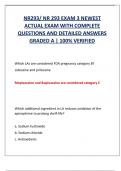Exam (elaborations)
A People And A Nation A History of the United States To 1877 9th Edition By by Mary Beth Norton - Test Bank
- Module
- American History Exam
- Institution
- American History Exam
Chapter 3—North America in the Atlantic World, SHORT ANSWER Instructions: • Identify each item. Give an explanation or description of the item. Answer the questions who, what, where, and when. • Explain the historical significance of each item. Establish the historical context in whi...
[Show more]












